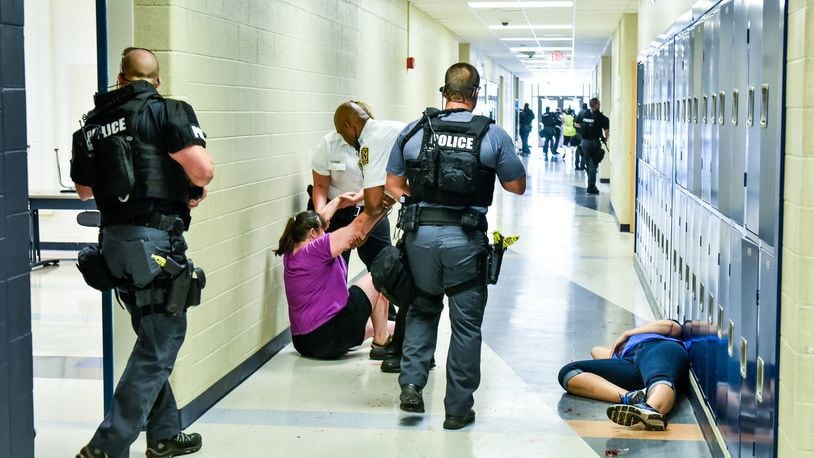It’s an unprecedented development in the now accelerated evolution of how Ohio’s 613 public school systems may now combat an armed attacker and throws the onus on to local school boards and other district leaders to enact new security policies if they choose to do so.
Lakota officials moved quickly Thursday to schedule discussions of security options, announcing the cancelation of two previously scheduled school board committee meetings on Friday concerning diversity and policy to instead hold a board safety committee meeting.
The 17,000-student Lakota district, which is the ninth largest in Ohio, has long practiced a policy of discussing school security matters in only the most general fashion so as to not publicize specific school building security procedures that may be used by a potential attacker.
And board members, according to the safety committee announcement, intend to maintain that secrecy as its members consider their response to the new state law options now available to them.
“The committee will immediately enter into executive session to discuss details relative to the security arrangements and emergency response protocols,” according to the announcement.
Separately, in a regularly scheduled online public discussion Thursday by Lakota Superintendent Matt Miller, he said “events like this (Texas shooting) cause us to re-evaluate what we are doing and lessons learned.”
Miller said the district is considering increasing its number of armed officers, which currently are deployed at each of the district’s 24 school building campuses.
“I’m not really a proponent of minimal … training on a (gun) range and having somebody certified to carry a weapon in school,” he said.
But he added, “I will have conversations about that at the board level and also with our resource officers … West Chester (police) and the (Butler County) sheriff’s department about what that looks like.”
“It’s not a clear cut, easy decisions and there are a lot of things that go into making that call and making us as safe as we can be.”
On Thursday, the state bill’s sponsor - Ohio Rep. Thomas Hall (R-Madison Twp.) – said at a press conference the goal of the bill is to “protect and enhance school safety” and it’s best to have “a good person with a gun to stop a bad person with a gun.”
It’s a security strategy long advocated by Butler County Sheriff Richard Jones and for a while, until Ohio courts ruled against them, the arming of some trained, volunteer school employees was the policy at Madison Schools, after a student shot and wounded three classmates in 2016 in the high school cafeteria.
But other education officials and organization quickly condemned the option of arming volunteer teachers, or non-teaching staffers, as a dangerous overreach that will add potential deadly force to schools better served by using local police officers or other means to protect students and employees.
And they blasted the lowering of handgun training hours from 150 to 24 hours as severely lacking.
In a joint statement urging Ohio Governor Mike DeWine, who has said he supports the new law, to veto the bill, officials with the Ohio Education Association and Ohio Federation of Teachers said: “We know putting more guns into school buildings in the hands of people who have woefully inadequate training—regardless of their intentions—is dangerous and irresponsible.”
“Teachers and other school employees should not be asked to serve dual roles as educators and school safety personnel armed with weapons, but, if they are, rigorous training standards, as set under current Ohio law, are essential.”
A better strategy, according to officials with Warren County’s largest school system, is a varied approach that includes an emphasis on identifying potentially deadly threats, especially from troubled students, through mental health counseling and support.
Tracey Carson, spokeswoman for Mason Schools, said while the district also employs armed school resource officers, she understands each Ohio school district’s approach to how it will go about protecting itself from an armed attack is a local decision.
“We appreciate that each school district’s unique location and needs will often dictate unique solutions. In Mason, four of our five schools are located within a quarter mile of the city of Mason’s police headquarters and the other school is less than two miles away,” said Carson.
“In addition, following the terrible Parkland, Florida (school) shooting (in 2018) we invested in an important $1 million partnership with the city of Mason to create a campus safety team that ensures we have armed law enforcement officers in all of our schools.”
But Mason Schools also emphasizes extensive mental health wellness measures, she said.
“When we see patterns of behavioral or mental health concerns, we work with our teams of mental health providers to refer and provide wraparound support for students both while at school and in the community.”
“If there is ever a significant concern regarding student mental health, suicidal ideation, or a threat to school safety, the district completes an in-depth risk/threat assessment on the student to determine immediate and future steps needed to support the student and family,” said Carson.
“Those assessments include input from our partner medical professionals as well as local law enforcement to help us ensure that the student has all of the necessary support in place.”
(Staff Writer Rick McCrabb contributed to this story)
About the Author
